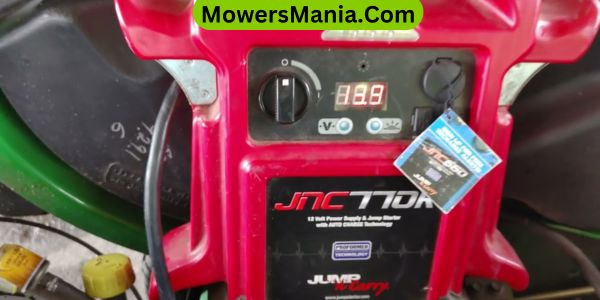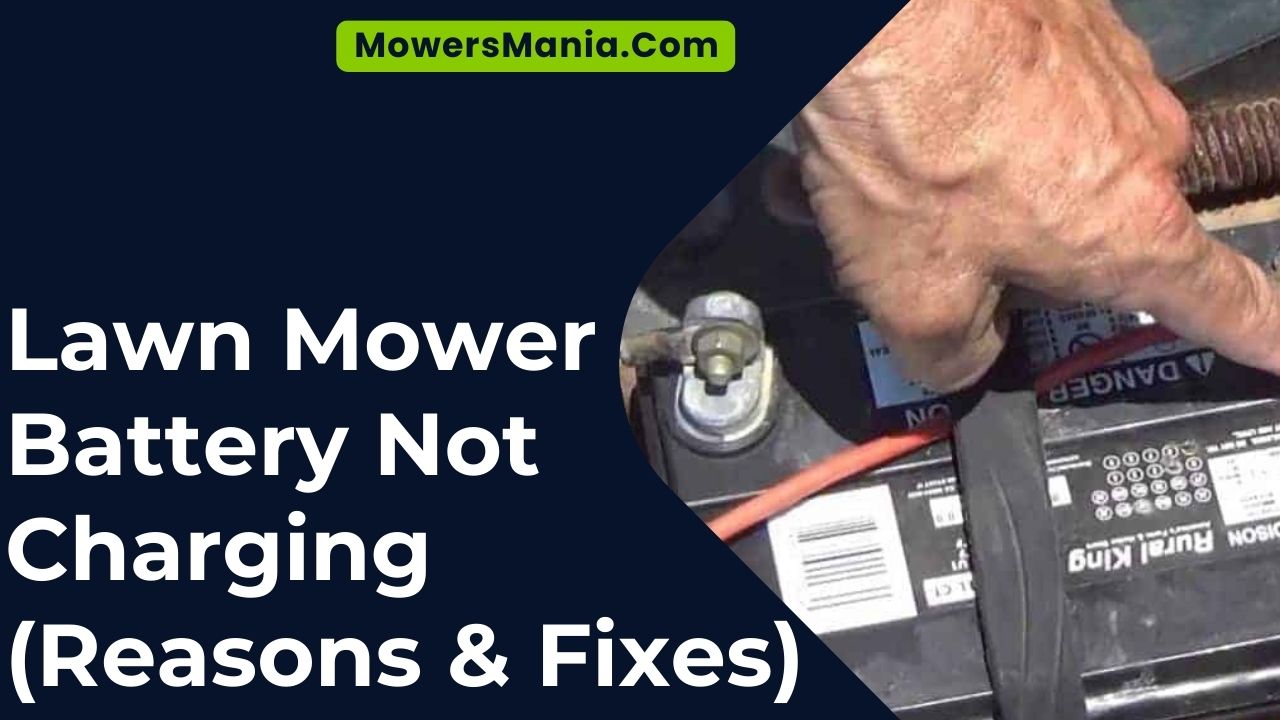So, your trusty lawn mower battery isn’t feeling up to the task of charging, huh? It happens. There are a few common reasons for this annoyance, but don’t worry – we’ve got some fixes for you.
From troubleshooting the charging system to DIY solutions, we’ve got your back. In this guide, we’ll walk you through the signs of a failing battery, reasons for it not charging, and the steps you can take to get it back in action.

And hey, if all else fails, we’ll point you in the direction of some professional help.
Let’s get that mower up and running again!
Common Reasons for Battery Not Charging
First, check the battery connections for any corrosion or loose wires that may be preventing the charging process.
Corrosion can hinder the flow of electricity from the charger to the battery, while loose wires can disrupt the charging circuit. If you notice any corrosion, gently clean the terminals using a mixture of baking soda and water.
Be sure to disconnect the battery before cleaning to avoid any electrical hazards. Once the connections are clean, tighten any loose wires to ensure a secure connection.
Next, inspect the battery for any signs of physical damage, such as cracks or bulges. A damaged battery may not hold a charge properly, leading to charging issues.
If you spot any damage, it’s essential to replace the battery with a new one to restore proper charging functionality.
Additionally, evaluate the charging system, including the voltage regulator and alternator, to ensure they’re functioning correctly.
A faulty charging system can lead to inadequate charging of the battery. If any issues are detected, consult a professional for repairs or replacements to the charging system components.
Worx 40V 14″ Cordless Lawn Mower Battery
Signs of a Failing Lawn Mower Battery
If your lawn mower battery is failing, you may notice dim or flickering headlights while starting the mower. This is a clear indicator that the battery is struggling to provide enough power to start the engine and keep the electrical components running.
Another sign of a failing lawn mower battery is difficulty starting the engine, especially when the mower has been sitting for a while. You might hear the engine turning over more slowly than usual, indicating a lack of power from the battery.
Additionally, if the battery is failing, you may experience intermittent or weak cranking when trying to start the mower. This can manifest as a sluggish or hesitant response when turning the key in the ignition.
Keep an eye out for a battery that seems to struggle to hold a charge, requiring frequent recharging or jump-starting. If you notice any of these signs, it’s important to address the issue promptly to avoid being left with a non-starting lawn mower.
Troubleshooting the Charging System
To troubleshoot the charging system of your lawn mower battery, begin by inspecting the battery terminals for corrosion or loose connections.
Corrosion can prevent the battery from charging properly, so clean the terminals with a wire brush and a solution of baking soda and water. Once you’ve checked the terminals, move on to testing the charging system components.
Here’s a helpful table to guide you through troubleshooting the charging system:
| Issue | Possible Cause | Solution |
|---|---|---|
| Battery not holding a charge | Faulty battery or charging system | Test the battery and charging system components |
| Loose or damaged wiring | Poor electrical connections | Inspect and replace any damaged wiring |
| Faulty voltage regulator | Inconsistent charging | Test the voltage regulator and replace if necessary |
| Malfunctioning alternator | Inadequate power generation | Test the alternator for proper functioning |
DIY Fixes for Charging Issues
When troubleshooting charging issues with your lawn mower battery, start by inspecting the battery terminals for corrosion or loose connections.
Oftentimes, a simple cleaning of the terminals can resolve charging problems. If the terminals are corroded, use a mixture of baking soda and water to gently scrub the corrosion away with a wire brush. After cleaning, apply a thin layer of dielectric grease to the terminals to prevent future corrosion.
Next, check the battery cables for any signs of damage or wear. Look for frayed wires or loose connections and tighten any loose cable clamps. If you notice any damaged cables, it’s best to replace them to ensure a secure connection.
Finally, assess the battery itself. If it’s an older battery, it may have reached the end of its lifespan and might need replacement. Additionally, check the electrolyte levels in the battery and top them up if necessary, following the manufacturer’s recommendations for the specific battery type.
When to Seek Professional Help?
When experiencing persistent charging issues with your lawn mower battery, consider seeking professional help. While many charging issues can be resolved with DIY fixes, there are times when the problem may be beyond your expertise.
Here are some signs that indicate it’s time to consult a professional:
| Signs to Consider | Description |
|---|---|
| Battery doesn’t hold a charge | If your battery fails to hold a charge despite multiple attempts to fix it, it may be time to seek professional assistance. |
| Visible damage | If you notice visible damage to the battery or its components, it’s best to have a professional inspect and handle the situation. |
| Unusual sounds or smells | Strange noises or odors during the charging process could indicate a serious issue that requires professional attention. |
| Previous unsuccessful DIY attempts | If you’ve attempted DIY fixes without success, it’s a clear indicator that professional help is needed to address the problem effectively. |
Seeking professional help when these signs are evident can save you time and frustration. Don’t hesitate to reach out to a qualified technician who can diagnose and resolve the charging issues with expertise and precision.
Frequently Asked Questions [FAQs]
Can I Use a Regular Car Battery Charger to Charge My Lawn Mower Battery?
Yes, you can use a regular car battery charger to charge your lawn mower battery. Make sure to use a low amp setting and follow safety precautions. It’s a convenient and effective option.
Is It Possible for a Faulty Alternator to Cause the Lawn Mower Battery Not to Charge?
Yes, a faulty alternator can cause the lawn mower battery not to charge. When the alternator is not functioning properly, it won’t provide the necessary power to recharge the battery, leading to a lack of charging.
How Often Should I Replace My Lawn Mower Battery?
You should replace your lawn mower battery every 3-5 years. Regular maintenance and checking for signs of wear and tear can help you determine when it’s time for a replacement. Keep an eye on the battery’s performance.
What Are Some Safety Precautions to Keep in Mind When Troubleshooting or Fixing the Charging System of a Lawn Mower?
When troubleshooting or fixing the charging system of a lawn mower, make sure to wear protective gear, disconnect the battery, and work in a well-ventilated area. Avoid working on wet surfaces and consult the manual for guidance.
Will Using a Higher Voltage Charger Damage My Lawn Mower Battery?
Using a higher voltage charger can damage your lawn mower battery. It’s important to use the charger specified for your battery to avoid overcharging and potential harm to the battery’s lifespan and performance.
Conclusion
So if your lawn mower battery isn’t charging, don’t panic. Start by checking for common issues like a damaged battery or faulty charging system.
Look out for signs of a failing battery and troubleshoot the charging system to identify the problem.
You can try DIY fixes like cleaning the connections or replacing the battery if needed.
If all else fails, don’t hesitate to seek professional help to get your lawn mower up and running again.




